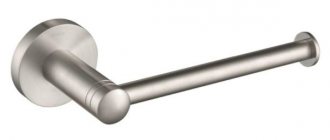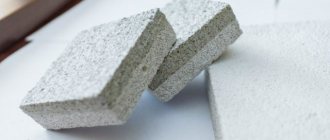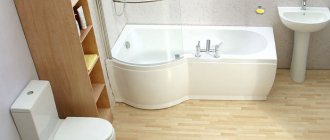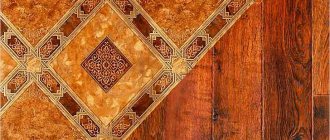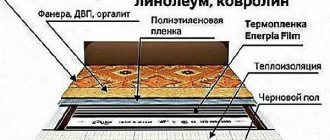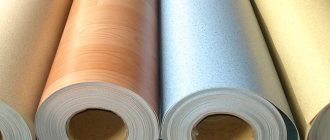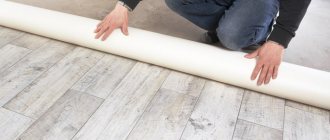The technology of installing linoleum on a heated floor is not so popular. The reason lies in the fact that during the heating of this material, vinyl chloride, toluene, phenol, etc. are released. And this is true, but not in all cases. Considering the above, a reasonable question may arise: is it possible to lay linoleum on top of heated floors? This article will provide objective information that will allow you to understand whether it is possible to lay linoleum on a heated floor. You can also read reviews from those who have researched this issue. In general, this will help you choose linoleum wisely and create an equally effective underfloor heating system as with parquet or tiles.
Marmoleum production technology
It is possible that many readers saw the name “marmoleum” for the first time and rightfully believe that this is the latest invention in the field of finishing materials. This is partly true, but only regarding the improvement of the material. The very idea of producing marmoleum arose a very long time ago - back in 1863, almost simultaneously with the invention and receipt of a patent for the production of ordinary linoleum. Manufacturers have noticed that durable fabrics of natural origin, such as jute, which was obtained from fibers of plants of the linden family, retain their appearance and strength much longer if they are additionally impregnated with oil. Such fabric, additionally coated with various hardening compounds, was used for covering floors. Taking this idea as a basis, British manufacturers invented an improved type of linoleum - marmoleum, which consisted entirely of natural ingredients. It includes the following materials:
- Cork tree;
- Jute;
- Tree bark;
- Plant resins;
- Wood flour;
- Chalk;
- Lime;
- Natural oil;
- Natural dyes.
The production technology is also not particularly complicated. All components are mixed together in certain proportions. The resulting mixture is aged for 10 days so that the components are better mixed with each other and a single homogeneous mass is obtained. After this, natural dyes are added to the composition and mixed thoroughly. The finished mixture acquires the required size and shape by pressing, and then is dried in specialized chambers.
Due to the fact that the components included in the composition can be called cheap, marmoleum is practically not counterfeited due to the inexpediency of this undertaking. The output is a material that is almost identical in its properties and characteristics to ordinary linoleum, only completely natural.
How to lay marmoleum on film heating elements?
The technology is practically no different from the one described above. But first, the warm infrared floor under linoleum needs to be prepared, namely, the film needs to be covered with dense material. After the system has been checked, a vapor barrier must be laid on top of the film to prevent condensation. The vapor barrier material (for example, PET film) should overlap the walls by 50 mm.
Next, the system should be covered with fiberboard, plywood or OSB with a thickness of no more than 6-8 mm. The material must be secured to the floor with self-tapping screws, but only along a line where there are no heating elements. Sand the joints of the sheets so that there are no noticeable differences.
Types of marmoleum
Based on form and possible sizes, marmoleum comes in three types:
- Rolled - consists of sheets 1.5-6 meters wide. Its thickness can be 2-4 mm. The weight of one roll can reach about 120 kg, which means that it will be very problematic to independently install this form of marmoleum within an ordinary apartment. Therefore, rolled marmoleum is most often used for covering floors in large areas - in shopping centers, offices, large playgrounds, etc. In this case, installation and transportation are carried out using specialized equipment. Another feature that complicates working with rolled natural linoleum is its increased fragility. It is not recommended to unroll the roll more than once. With repeated twisting, many cracks are sure to form on the surface. Such material is no longer suitable for use;
- Tile - resembles thin tiles. It comes in two sizes - 30x30 cm or 50x50 cm. This form of release is the most convenient for tiling the floor in an apartment;
- Panel - looks like a laminate plank, only smaller in size and wider - 90x30 cm. This form is also quite suitable for self-installation.
We lay natural linoleum according to the rules
As for the installation of marmoleum, experts advise using a wooden or rubber hammer in the process, the hook of which is at least 150 mm.
If you decide to lay the material yourself, then remember several important nuances:
- It is allowed to lay marmoleum directly on the old floor covering and use any mounting adhesive. However, if the old coating has depressions and shakes, then you need to remove it and lay a new one directly on the concrete surface.
- On the old coating, tile marmoleum is laid end-to-end with glue. It is not recommended to use the panel type, since if the old floor is rough, the panels will constantly get stuck during the fitting process.
- If you are laying the material directly on concrete, then before installation, be sure to prepare the floor - eliminate all unevenness, vacuum it from dust and debris. It should be smooth, clean and dry.
Marmoleum wear resistance classes
Tile and panel marmoleum consists of three layers. The first is a cork substrate, 1 mm thick. This layer is noise-insulating and heat-insulating. It helps reduce noise levels by 20% and prevents the penetration of cold from concrete floor slabs into the home. The second layer is a moisture-resistant HDF board. Some manufacturers, for ease of installation, additionally mill the locking joint around the perimeter of the slab, as on a laminate. The third layer is the marmoleum itself. Its thickness depends on the class of material.
There are three wear resistance classes in total :
- Class 21-23 is considered the thinnest - the thickness of the top layer is 2 mm. Accordingly, its cost is lower. This is a type of general purpose natural linoleum most suitable for home use.
- Class 31-33 – marmoleum for industrial use. The thickness of its top layer is 2.5 mm and is resistant to static loads. Less common, but still applicable for home decoration.
- 41-43 class – the thickness of the decorative coating reaches 3 mm. This coating is intended for areas with high traffic and intense loads. Such a floor can withstand up to 100 thousand steps per day for 5 years. This material is used for flooring in large airports, industrial buildings, shopping or office centers.
Don't think that the thicker the marmoleum, the better. To cover the floors in an apartment, class 21-23 material is sufficient , which not only easily withstands frequent loads, but is also not sensitive to static loads. In other words, the legs of even the heaviest pieces of furniture will not leave characteristic marks on the floor even after many years. The same cannot be said about the coverage of class 41-43.
When choosing the size of the covering, proceed from the area of the room. Larger panels look harmonious in larger rooms. Large fragments of flooring can once again draw attention to the modest size of the room. This is true in the case of a combination of several colors of marmoleum or laying it with deliberate cutting of the seams and subsequent grouting. If you intend to cover the floor with a plain material without seams, then select the most optimal form of release in terms of size. Measure the length and width of the room and calculate how much waste will be generated when laying tiles, and how much when laying panel marmoleum. Choose the variety with the lowest number and pruning rate.
Which heated floor to choose for linoleum
The choice of a floor heating system depends on several factors:
- type of living space;
- type of linoleum.
Water-heated floors can be used in private housing construction: country houses and cottages, provided that the flooring is natural linoleum. There are simply no other combinations. Electric cable flooring can be installed in apartments and private houses under marmoleum and glyphthalic linoleum.
IR film is used as the main and additional heating in any premises under natural, vinyl and glyphthalic linoleum. If you evaluate heating systems based on efficiency and ease of installation, then the choice is clearly in favor of an infrared floor. You can verify this by looking at the articles “Which underfloor heating is better - water or electric?” and “Which warm floor for tiles is better to choose?”
Taking into account the choice made, we will consider in detail how to install an infrared “warm floor” under linoleum.
Advantages and disadvantages of natural linoleum
Of course, one cannot fail to note the advantages and positive features of this type of flooring:
- Marmoleum has virtually no residual deformation and is able to withstand loads of 160 kg/cm2;
- Due to the use of natural ingredients during production, it is safe for health and does not cause allergic reactions;
- In addition, it has a bactericidal effect and improves the indoor microclimate;
- Natural linoleum has noise-insulating and heat-saving properties;
- When laying marmoleum, no particularly thorough surface preparation is required. Thanks to its plasticity, it will repeat small irregularities up to a quarter or even a third of its thickness, while its front side will remain smooth;
- Due to the fact that the material can be colored throughout its entire thickness, even if scratches appear on the surface , they will be practically invisible . Accordingly, marmoleum is able to maintain its attractive appearance much longer;
- The coating is resistant even to prolonged exposure to ultraviolet rays, various detergents with chemical compositions, and does not become wet or swell when exposed to moisture;
- There will be no traces of aggressive dyes left on its surface. Even the paint is easy to mark and will not stick. Thanks to this, caring for marmoleum is very simple and enjoyable;
- Natural linoleum does not accumulate static electricity, which means it does not attract dust;
- It is fireproof and does not support combustion. A cigarette butt thrown onto the surface of marmoleum will simply fade away and will not even leave a burn. It is very difficult to burn through the coating;
- The color palette, as well as the variety of textures of natural linoleum, is very large. Its surface successfully imitates natural wood or stone. There are over 100 primary colors and over 2000 shades for you to choose from;
- Laying marmoleum is quite simple and does not require any special skills;
- And finally, the most important thing is that the service life of such coating is about 20 years. This is despite the fact that it is able to withstand exposure to water, chemicals and heavy power loads. And thanks to the fact that the material is constantly being improved, we can hope that this figure will soon increase.
Like any other material, marmoleum also has a number of disadvantages:
- The material is very fragile . Especially its edges, which quickly chip off due to careless movements or improper transportation. Rolled marmoleum is generally not intended for repeated folding/unfolding;
- We can say that its weight is quite impressive - 2.6-3.4 kg/m2. Therefore, marmoleum is used only for flooring. On the walls it will simply float under its own weight;
- Due to its layered composition, the material is difficult to cut . To do this you need to use a hacksaw with fine teeth. But even with such a tool it will not be possible to achieve a perfectly smooth edge;
- In connection with the above, certain restrictions arise during installation. Firstly, it is not recommended to cut slabs or panels into pieces and try to lay them out in a specific color sequence. You will never achieve smooth joints using this method. Secondly, trimming should only be done for slabs adjacent to the wall, where the defect can be hidden with a decorative plinth. But this is not a drawback, but a recommendation. After all, you can lay out the desired pattern with ready-made tiles of different colors;
- After some time, the marmoleum hardens and spreads a little to the sides, but this feature can hardly be called a disadvantage, because on the contrary it is good for flooring. Not only does the surface hardness increase, but also small gaps in the joints of the plates will close by themselves. You don't have to put any effort into this. Knowing this fact, before purchasing, always check the date of manufacture and packaging of the coating. Otherwise, already hardened and floating slabs will be very difficult to lay.
When purchasing, also pay attention to the availability of a warranty and the possibility of replacing the product if it is damaged. Remember - the material is very fragile. If packaging and transportation are not carried out properly, you will pay money for a chipped product, will not receive the proper type of coverage and will not have the opportunity to change it. There are also restrictions regarding the location of its installation. Manufacturers do not recommend laying marmoleum on top of a heated floor.
I see its thermal insulation properties, you will not get the amount of heat you expected. And despite its resistance to moisture, it is not recommended to cover the bathroom floor with it.
Advantages
There are many advantages of natural flooring:
- low thermal conductivity and resulting in good thermal insulation properties;
- environmental friendliness;
- can withstand loads of up to 160 kg per cm2;
- good sound insulation;
- fire safety - marmoleum does not support combustion well;
- non-toxic and hypoallergenic;
- bacteriostatic properties;
- a large selection of coatings in bright colors with many shades. However, in addition to plain coatings, there is material with patterns, “like wood”, “like natural stone”;
- Static electricity does not accumulate. In particular, dust is not attracted to the floor;
- durability. In principle, you can count on a minimum of 20 years of operation;
- the design does not fade and does not fade during the entire period of use;
- marmoleum is more resistant to acids, alkalis, and household chemicals compared to linoleum;
- the surface has anti-slip properties;
- hygiene and practicality - the coating is easy to clean. As a result, marmoleum can be used in medical and children's institutions.
Average cost of marmoleum
This question immediately arises after familiarizing yourself with the advantages of this finishing material. Everyone wants to purchase natural and durable coatings at a reasonable cost. It should be understood that the cost is determined by several factors:
- Form of release of the floor covering;
- The thickness of its decorative layer;
- Strength class;
- Decorative properties.
Accordingly, it will be much cheaper to buy a plain marmoleum of class 21-23 than a material that imitates wood or has a bright shade of strength class 41-43. The cost per square meter of rolled marmoleum starts from 600 and reaches 2300 rubles. Tile material measuring 30x30 cm can cost about 1,500 rubles. per package containing 7 slabs. Panel marmoleum reaches a cost of 4,000 rubles. for a package with the same number of elements. The price range is very wide. This makes it possible to purchase a natural coating depending on your financial capabilities, but not completely abandon the purchase.
It is quite difficult to give exact figures due to the regular arrival of new varieties of material. But if we average, we can say that it occupies an intermediate position between synthetic linoleum and natural wood coverings. Some types of laminate may cost more than marmoleum.
Compliance with thermal conditions
As a rule, each manufacturer provides the necessary information for choosing a product on the packaging in the form of special markings. When choosing, you can also rely on customer reviews, this will help you make your choice faster.
Directly next to the marking the permissible value of the heated temperature is indicated. For example, for marmoleum it is about 27 °C. If the heating exceeds this indicator, the linoleum will soften and may subsequently tear. As for vinyl, it can be heated up to 30 °C without negative consequences. Just as in the first case, at elevated temperatures linoleum will begin to lose color and deform. Moreover, there is a risk of release of phenol and other gases.
To prevent severe overheating of linoleum, the heated floor must be equipped with a thermostat, which will ensure even heating of the floor covering.
The best marmoleum producers
Despite the growing popularity of marmoleum, not many manufacturers produce this flooring. We will look at the most popular manufacturers who have proven themselves to be the best and have collected the largest number of positive reviews about their products:
Tarkett-Sommer
The company is the result of a merger of two major flooring manufacturing companies. Today, the new concern Tarkett-Sommer produces about 300 million sq.m. flooring per year. With such figures, the quality of coverage remains at the best level. In total, this company presented two lines of natural linoleum.
- The first, called Linosom Veneto, includes 44 colors. The surface of the coating imitates the color of natural marble. This marmoleum is intended for installation in public places - educational and medical centers, entertainment or industrial premises. However, it can also be used for installation in an apartment. Release form: rolls, 200 cm wide and decorative coating thicknesses 2, 2.5, 3.2 mm.
- The second line is called Narnidur and includes a total of 8 colors. This coating is designed for use in harsh conditions. It is used for flooring in industrial and manufacturing enterprises or sports fields. It combines good elasticity and durability.
Forbo
The manufacturing company, originally from the Netherlands, occupies a leading position in the production and sale of natural linoleum. The quality of the products is confirmed by numerous certificates. He gave his products the name Marmoleum. The collection includes more than 300 types of various textures and shades. Particularly popular is marmoleum in the form of slabs and planks with locking joints. The entire variety of flooring under the Marmoleum brand can be divided into several main groups:
- Marmoleum Real - available in rolls 200 cm wide. The thickness of the decorative layer is 2, 2.5, 3.2 mm and imitates a marble surface. This is a category of particularly wear-resistant natural linoleum;
- Marmoleum Fresso is a more refined flooring with a surface reminiscent of ancient frescoes. The thickness of the top layer is 2.2.5 mm;
- Marmoleum Walton - a single-color coating of various colors and shades with a decorative layer thickness of 2, 2.5 mm;
- Marmoleum Artoleum is the most unique line with a textured surface. Sometimes on the surface you can find reproductions of paintings by famous artists;
- Marmoleum Click is a three-layer coating that consists of a 1 mm thick cork backing, natural waterproof HDF chipboard with a click joint and a 2.5 mm thick layer of marmoleum itself. Available in the form of slabs measuring 30x30 cm or planks measuring 90x30 or 60x30 cm. Includes 23 color options.
Armstrong DLW
A German company that produces its products under the Marmorette logo. It is characterized by simple installation, increased fire safety, wear resistance and durability. There are three lines of flooring:
- Marmorette LPX 2.5 – the coating of this series imitates a marble surface and has a decorative layer thickness of 2.5 mm. It has antistatic and antibacterial properties. Available in rolls 200 cm wide. Used for flooring in a wide variety of rooms. Wear resistance class – 23/34/42.
- Marmorette LPX 3.2 is a coating created for commercial enterprises. It has similar properties as Marmorette LPX 2.5, but has a top layer thickness of 3.2 mm.
- Marmorette PUR 2.0 – this line of coating is characterized by the presence of a multi-colored camouflage welding cord. The surface imitates a non-directional marble color, which is why it is very popular. Release form: rolls with a width of 200 cm and a top layer thickness of 2 mm.
- Marmorette PUR 2.5 – the coating has a marble structure and includes a special layer called PUR Eco System, which provides resistance to mechanical damage. The thickness of the top layer is, respectively, 2.5 mm, the release form is rolls 200 cm wide.
- Marmocor Lino Eco LPX is the most cost-effective flooring line. The price starts from 1300 rubles. per sq. meter. Available in roll form 200 cm wide with a decorative layer thickness of 2 or 2.5 mm. Includes 12 available textures. While other lines include 51 textures each.
The products of the last two manufacturers have almost identical composition and technical characteristics. The only difference is that Forbo uses wood flour in its production, and Armstrong DLW uses wood cork.
↑ A little about Forbo marmoleum
It is impossible not to say about the manufacturers of quality products, or rather about one of the manufacturers whose reputation leaves no doubt. The Forbo brand, specializing in the production of flooring, was founded in 1928. The company's branches are located in 40 countries of the European Union, the brand's products are recognizable and revered due to their high quality, confirmed by numerous certificates.
forbo marmoleum meets all necessary environmental standards, as proven by tests from 7 leading laboratories in the world: Environmental Quality Mark (Netherlands), Ecolabelling Trust (New Zealand), Good Environmental Choice (Australia), SMART (USA), UZ 56 (Austria), Nordic Swan Label (Northern Europe) and Nature Plus (Germany).
Marmoleum forbo is a time-tested brand
Forbo “click” marmoleum is especially popular, equipped with a locking mechanism using Aquaprotect technology. This coating is produced in the form of boards or tiles based on cork and moisture-resistant NDF, which is coated with a special protective layer Topshield.
The quality of forbo marmoleum is confirmed by tests
A variety of color variations and patterns provide the opportunity to lay floors that are artistically unique. Forbo marmoleum is not afraid of the claws of pets, thin women's stiletto heels and heavy shoes. It will not be difficult to wipe off chewing gum or paint stains. It is not for nothing that the coating received the title of “indestructible” - where laminate, parquet, cork board or carpet are hopelessly damaged, marmolu will serve and delight you with its impeccable appearance for quite a long time.
Laying marmoleum with your own hands
Now let's move on to the detailed technology for self-laying marmoleum and the main nuances of this event. Any facing work should begin with surface preparation:
- If marmoleum will be laid on a wooden base, be sure to ensure its integrity and mechanical strength. Damage to floorboards in the form of cracks, broken planks or large differences in height is unacceptable. If such damage still exists, lay an additional layer on the floor, such as OSB boards or thick plywood. At the same time, pay attention to the presence of squeaks. If you cannot eliminate them, it is best to remove the old wooden flooring. After all, marmoleum is laid not for one or two years, but for decades. You can imagine what condition the wooden floors will be during this time, and what sounds they will make.
- If natural linoleum is laid on a concrete surface, it must first be leveled. A perfect mirror plane is not required, but all protrusions and sharp edges must be cleaned. Dents that are too deep should be repaired with putty or any other available solution. After complete drying, the floor must be thoroughly swept or vacuumed. This is necessary to maximize the fit of the material and minimize the thickness of the joints.
Once the surface of your floor meets all the requirements, you need to the tools necessary for the installation process and adjust the material. Remember that marmoleum is a fragile material. And if you chose it in the form of slabs with a locking connection, it may be necessary to knock them down during the process. Also, do not forget about the need for pruning. So, we need:
- Rubber hammer and wooden spacer;
- A hacksaw or jigsaw, the file of which should have fine teeth and the opposite direction;
- Pencil and ruler.
Now you need to decide on which side of the room it is better to lay the trimmed elements and how many there will be. To do this, you need to spread the material on the floor.
Keep in mind that marmoleum is subject to thermal expansion. As temperatures increase, it will slightly increase in size, and when temperatures decrease, it will return to its original values. In this regard, first step back 1-1.5 cm from each wall in the room. You can draw a limiting line, but it is best to place wooden planks of the appropriate width on the floor. This will not only make it clearer, but also give emphasis. Only after this measure what size you need to cut the coating to.
It is better to trim the outer rows that will go under furniture, radiators or other masking objects. Many people recommend leaving the marmoleum in the room where it will be installed for a day so that it reaches the required temperature and becomes more flexible. After the material has rested, you have marked and cut, you can proceed directly to the masonry process. Let's take a closer look at the nuances of working with different forms of marmoleum.
Laying tile marmoleum
Installation of slabs can be done in two ways:
- With selection of drawing;
- Without choosing a picture.
In the first case, work must begin from the middle of the room, moving towards the edges. In the second case, installation is carried out starting from the smallest wall. Boards with a locking joint that does not require applying glue to the reverse side must be laid on a polyethylene backing to avoid the formation of condensation. To do this, use ordinary film, which is laid on top of each other with an overlap of 20 cm. The joints are taped.
- The first tile is placed at the above distance from the wall. Be sure to ensure that the ridge is directed towards the wall and the groove is in the opposite direction. If you miss this moment, the tile simply will not snap into place;
- Next, fasten all the tiles of the first row together, placing them at a slight slope in relation to each other;
- When moving on to laying the second row of tiles, be sure to check that it is parallel to the plane of the wall. Such control should be done after laying each subsequent row;
- If necessary, use a rubber mallet and a wooden strip.
difference between laying slabs without a locking connection is that special glue or silicone is first applied to the surface of the base. You should not apply too much glue so that after pressing the tiles to the floor it will lick from all sides. Apply it in medium thick zigzags. What kind of glue you should buy will be indicated on the packaging of the floor covering. It’s better to immediately prepare a damp rag to remove any remaining adhesive from the surface of the boards before it dries. You can walk on the adhesive-based coating only after the time indicated on the adhesive packaging has expired.
Laying panel marmoleum
It is carried out by analogy with laying conventional laminate. But due to the increased fragility of the material, it is more complex. To keep the panels intact and ensure ease of working with them, the parts should be connected to each other strictly at a certain angle. Recommendations regarding its size should be indicated on the packaging. We recommend making wooden templates for yourself Take a couple of bars, draw a line on them corresponding to the required angle and file it down. Each time you join a panel to the previous one, first place the bars on the floor so that their sharp edge lies in the groove, and then slide the panel along them. When it's time to fasten the pieces, simply remove the templates.
Rolled natural lenolium flooring
Laying rolled marmoleum is done in exactly the same way as laying regular linoleum. Only in this case you will have only one attempt to unroll the coating correctly. It is advisable to use this type of material for flooring in large rooms. The base must be clean, free of greasy stains and residues of various building mixtures. Ideally, the floor is coated with a special adhesive. When the sheet has rested and straightened out, secure it around the perimeter with decorative skirting boards.
When laying lockless elements, you can intentionally leave gaps between them. To do this, matches are inserted between the plates. You can make both four-way and two-way seams, whichever you prefer. After the adhesive has completely dried, the matches are removed and the seams are filled with grout of the desired color using a rubber spatula.
Any type of marmoleum is very easy to care for. But in order to maximize its service life and avoid scratches, it is not recommended to use too hard brushes for cleaning. Hand dry cleaning is preferred. To remove difficult stains, use a damp, soft sponge and non-abrasive, gentle detergents. Many people recommend using specialized products for caring for hard floors - maintainers.
Features of coating care
Marmoleum is a natural flooring material that is very popular around the world. However, he also needs care. The coating is easy to use, however, to prevent the formation of defects on the surface, during the cleaning process, avoid the use of abrasive materials, iron scrapers or brushes. It is better to choose soft and dry rags for this purpose.
Caring for marmoleum coating is not difficult.
If stains have formed on the coating and wet cleaning is required, then it is worth using neutral detergent compositions. Many people recommend using special hard floor care products.
In our country, this type of flooring is still new; installation methods have not yet been perfected, but any building material has gone through such a stage, and accordingly, it is likely that marmoleum will soon be able to completely replace laminate and linoleum.
What should you pay attention to when purchasing?
- In an attempt to save money and purchase expensive coverage at more than affordable prices, many of us are tempted by all sorts of promotions. It is strictly not recommended to do this if you have never heard of this seller before. You can only agree to tempting offers from trusted stores and suppliers. Otherwise, you will either buy a obviously defective product, or they will refuse to return you if something happens. After all, many guarantees do not apply to promotional products;
- Before going to the store, read reviews on the Internet about the product you are going to purchase, especially if it is a young and little-known brand;
- Familiarize yourself with the composition and make sure that there are no foreign chemical impurities in it;
- Be sure to check the lot number before purchasing. They should be the same. Different batches may have color differences, which will be very noticeable after installation;
- If possible, inspect all locking connections for their integrity;
- Do not strive to purchase the highest class coatings for home use;
- Pay attention to the integrity of the edges of the rolled material;
- Immediately purchase specialized glue, if necessary;
- Check the availability of a warranty on the material and the possibility of exchanging defective products.
The article was written for the site.
Tags: Flooring
Materials and tools
To assemble a “warm floor” under linoleum you will need:
- infrared “warm floor” kit, which includes:
- film with elements emitting infrared rays (sold in different widths: 50, 60, 80 and 100 cm);
- electrical wires;
- special clips for fixing the film on the insulation;
- contacts in the form of clips;
- bitumen-based tape.
- temperature sensor with wires;
- Temperature regulator;
- foil insulation (you can buy a backing with foil or lavsan on one side 3 mm thick);
- electrical tape for insulating wire twists;
- metallized tape;
- knife;
- roulette;
- pliers for crimping contacts;
- pliers for stripping insulation from wiring;
- construction pencil.
In addition, for the preparatory work you will need:
- hammer drill or wall chaser;
- electric drill with a crown.

